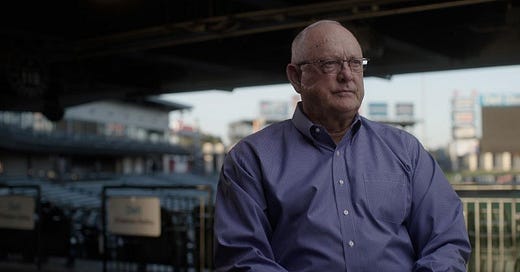Facing Nolan
This engaging documentary provides the definitive look at the life and career of arguably baseball's greatest pitcher, who always brought the heat.
When Nolan Ryan first hit the big leagues, nascent technology to measure ball speed clocked his heater at 101 mph. Catcher Jerry Grote, who caught him frequently as his New York Mets teammate, swears it was closer to 108.
He was basically Nuke LaLoosh from “Bull Durham” — a big, lanky kid with a lightning bolt for a right arm, but with control problems so bad at times he could barely keep it over the plate.
Twenty-five years later, Ryan was still pitching in the big leagues and his fastball was still clocking in the mid- to high-90s. And experts calculated that those early machines really did underestimate just how fast the native of Alvin, Texas could throw.
That’s just one of the insights to be found in “Facing Nolan,” the terrific new documentary about the legendary pitcher from director Bradley Jackson. It takes a figure who, now retired nearly 30 years, has firmly passed into baseball mythology, giving us the definitive view of the man and athlete.
There are extensive interviews with Ryan, his wife, Ruth, their children, grandchildren and friends. But also a voluminous roster of other observers, from baseball authors like Rob Goldman and Joe Posnanski to former Texas Rangers owner (and POTUS) George W. Bush.
And testimonials from other high-wattage baseball players who took the diamond for or against Ryan: Roger Clemens, Randy Johnson, Cal Ripken, Pete Rose and George Brett among them.
Having made a splash on the festival circuit, you can’t stream “Facing Nolan” anywhere right now, but I’d expect that to change real soon.
Ruth and Nolan met in the 4th grade, started dating in the 9th grade and are still together seven decades later. One of the things I appreciated was how the documentary gives her plenty of time in the limelight, showing how she not only supported but drove her husband to be the best he could be. A state tennis champion, their kids and grandkids even insist she’s the more competitive of the two.
Indeed, despite some early success as a relief pitcher with the Mets — including a magical game to win the pennant and, later, the World Series — Ryan wasn’t even a star and only made $7,000 a year, or about $54,000 today. He worked in the offseason as an air conditioning installer to pad out his pay.
His initial plan was to play for four or five years, long enough to secure a league pension. His first few seasons he carried animal medicine books around with him on the road, planning to become a veterinarian.
It was only after being traded to the lowly L.A. Angels that Ryan received his first reach pitching coaching from a man named Tom Morgan. He noticed that Ryan twisted his body so hard that his follow-throw would actually cause him to stumble off the mound. So he would stand just to his left, so Ryan would have to hit his coach if he didn’t stop in time, and found his long-elusive control.
He was ready to quit around age 24, but Ruth insisted he give it another year or two — which turned into that, and 20 more. Ryan pitched until age 46, a record 27 years in the majors. He wound up with 51 records, including most strikeouts and most no-hitters at seven, the last coming at age 44.
Astonishingly, Ryan never won a Cy Young Award, the annual award given to the best pitcher in the American and National Leagues. There’s a funny/sad sequence where the filmmaker asks other baseball legends how many Ryan won; most guess four or five and are astonished to learn it’s zero.
But that’s an unexpected theme of Ryan’s career: he was continually underestimated. Signing with the Houston Astros as a free agent to become the first athlete in any sport to earn $1 million a year, he gave the team some initial success before they experienced a long losing streak. The owner wanted Ryan to take a pay cut, so he wound up signing with the rival Texas Rangers at age 41. It was like Elvis entering the building, team officials recall. His mystique — and list of strikeouts — just continued to grow.
And yes, the movie does cover one of the most iconic moments in Ryan’s career, when a hitter half his age charged the mound after being plunked and found himself in a headlock with Ryan’s fist repeatedly pummeling his skull. Ryan was never shy about throwing inside, or even a little further, an example of what Pete Rose refers to as Ryan being “conveniently wild.”
The Ryan we see today is a quiet, grandfatherly figure, a bit thicker around the waist and with a big patch of scar tissue on the side of his face. But if he moves a little slower, his amiable good-naturedness and devotion to his family come shining through in this lovely, intimate portrait.
“Facing Nolan” is a wonderful example of showing us the legend, and then demystifying the man behind it. Somehow, getting to know the real person who owns all those records and stories only makes Nolan Ryan’s career shine that much brighter.





